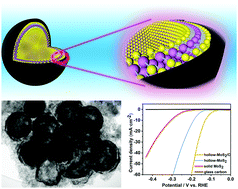First-principles and experimental investigation of carbon-coated MoS2 hollow nanosphere heterogeneous structures with enhanced hydrogen evolution performance
Abstract
In this work, we report the first-principles investigation and synthesis method for a hollow-MoS2/C heterostructure applied to a hydrogen evolution catalytic material. First principles investigation was used to calculate the free energy of hydrogen ion adsorption at the heterostructure interface at different surface adsorption ratios. The change of the density of states before and after carbon coating proved that carbon coating improves the conductivity of the catalyst. Higher reactivity areas and higher conductivity can significantly improve hydrogen evolution catalytic performance, which is also demonstrated by electrochemical testing. Hollow-MoS2/C exhibits a low onset overpotential of 96 mV and a low Tafel slope of 67.4 mV dec−1, as well as good catalytic stability. The composite catalyst prepared by a two-step method has a larger specific surface area and a larger porosity, can significantly suppress the collapse and stacking effect caused by the electrode circulation process, and improve the cyclic reversibility and stability of the material. This work is expected to provide a meaningful reference for solving the problem of cycling performance degradation of non-precious metal-catalyzed hydrogen evolution materials.



 Please wait while we load your content...
Please wait while we load your content...